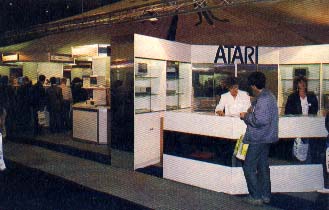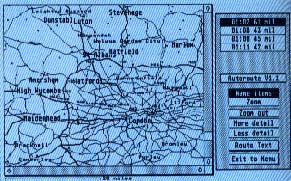The European Report
ATW, STOS and More
by Andre Willey
The annual Personal Computer Show is the largest and most important event on our home and small-business computer calendar here in England. This year, all the major U.K. and European manufacturers attended the show, held from September 14 to 18 at the Earl's Court exhibition center in London. True to form, Atari had the largest stand.
Perhaps "stand" is an understatement, villagemore apply describes the 6,900-square-foot area enclosed by three huge canopies emblazoned with the Atari logo. As in previous years, Atari used part of its stand to show off its own British and American products and leased the remainder to various manufacturers and retailers of third-party software and hardware.
 |
| Atari's booth at the Personal Computer Show in London. On the shelf in the center is the new Atari Transputer Workstation (ATW). |
Atari's Transputer Workstation
Atari showed the latest Abaq hardware, which has been renamed the Atari Transputer Workstation (ATW)--apparently due to complaints from a Belgian company that already owns the name Abaq.
The ATW looks startling and seems bent on shaking the number-crunching and graphics markets to their foundations. Already British television companies have shown great interest in using the ATW for broadcast graphics. And the ATW's multi-transputer environment could make any workstation almost as powerful as a Cray.
The ATW is now available to software developers in very limited quantities (about 50 units worldwide--is that limited enough?). At the moment, most of these are located in and around Europe. Perihelion of Cambridge, England developed the machine and the Helios operating system software for Atari. Perihelion hopes that Helios will become a standard for such multitasking transputer environments.
Housed in a plain gray and black box and connected to a Mega via the DMA port, the final ATW system will consist of a smart IBM-style casing, including a 3.5-inch disk drive, an external keyboard and a high-resolution color monitor. The user interface is very similar to the ST and all ST software will be compatible. The ATW will sell for a cool t3,000 to t4,000 (approximately $5,250 to $7,000) in the U.K.
The ATW's main processor is the Inmos T800-20 transputer (the 68000 is really used only as an I/O device). Contained in a single package is a very powerful CPU that includes fast data and bit-graphic movement commands, four kilobytes of on-board high-speed RAM and a 64-bit floating-point math co-processor.
The T800 transputer has three significant advantages over processor chips like the 68000 used in an ST. First, since there are fewer fundamental instructions, the chip can operate the refined set much faster. Second, the inclusion of local RAM and the math coprocessor allows the T800 to do most of its work without resorting to much slower bus communications with the outside world. Third, and perhaps most important, the T800 has been designed to communicate with other T800s via a high-speed 32-bit bus--enabling many transputers to work together to give almost unlimited potential speed. The ATW will be shipped with a single 20MHz T800 processor, but with sockets for another three.
But Can It Bounce the Ball?
It would seem that one essential item has been omitted from the ATW specification sheets, perhaps the most important piece of information you'll need before you purchase such an advanced piece of hardware. The processor speed, perhaps? Or maybe the memory capacity? Or what about the programming environment? No, something much more important: just how fast can the inevitable bouncing ball cavort around a high-resolution graphics display?
 |
Autoroute gets you where you're go- ing, as fast and economically as possible--at least if you're in England. |
Any computer worth its salt, it seems, must be able to rotate and bounce a colored soccer ball around the screen to prove its worth. Of course, it takes all sorts to make a galaxy and as one youthful Amiga/ST programmer said, "I can make that sort of demo run much faster using machine code, you know." Yes, we knew--but then not only was the transputer working in color resolutions that the ST can only dream of, but if it were really let off its leash, the ball would probably move too fast for anyone to see.
Back to the Show
Meanwhile, other exciting things were happening at the PC show. STOS, Mandarin Software's new ST BASIC interpreter developed by Jawx International of Paris, was prominently displayed. Not only is this a full-featured and very fast implementation of BASIC, but it also has a whole range of high-speed graphics and sound routines. These include multicolor sprite definition and movement, music composition and playback and automatic pixel scrolling in any direction. All of this makes STOS the ideal language for would-be game programmers. The price hovers around a meager $59.95. (Editor's note: STOS is currently available from Antic Software.) The German company DMC showed yet another early version of its Calamus desktop publishing package, which looks very impressive indeed. Finally, someone is giving the ST DTP software to match the likes of Ventura and Aldus PageMaker. As of this writing, Calamus is slated for a late October 1988 release. Tentative U.S. prices are $299.95 for Calamus and $449.95 for Calamus Plus.
Calamus was among the many products demonstrated on the plethora of large Megavision screen monitors. These are monochrome monitors that apparently work by revectoring GEM output to an interface plugged into the cartridge or DMA port that gives you a fully functional 19-inch GEM screen with about four times the workable area of a normal monochrome monitor. Its software provides such special features as the ability to use the normal ST display with the large screen, either as a zoom window or running another program. Any GEM programs that behave themselves should work with these display systems, but it's always best to check that any necessary applications run correctly.
And speaking of monitors, Cardiff-based Eagle Business Computers previewed their interesting touch-controlled screen modification. This $700 add-on fits over your standard monitor to let you control the mouse by pointing at the screen with your finger. All GEM functions are implemented. The system works using a resistive film basis, but the covering is so thin and transparent that you could easily mistake it for an anti-glare filter.
Mapping with Atari
British company NextBase showed its innovative new Autoroute map-and-route planning software. It provides a complete map of the UK, with all towns, villages and major roadways listed. For example, if you want to travel from London to Liverpool, simply give the ST the two locations and let it do the work. Autoroute takes into account your preferences for major, minor or motorway driving, type of vehicle, places to visit en route and so forth. It can even give you the fastest or most economical routes as well as the total distance and estimated journey time. Autoroute presently only covers the UK but NextBase hopes to release European and American versions in the near future. Unless you travel a lot, you might find the price tag of $260 a bit excessive.
And That's a Wrap
There just isn't enough space to cover everything at the great PC Show. Suffice it to say that there were plenty of colorful, noisy new games to choose from, plus some great new applications software including a very advanced Optical Character Recognition package and fiber-optic networking system that supports up to 26 linked STs. I'd say the show was a success.
On a closing note: I recently had the pleasure of attending one of Jean-Michel Jarre's amazing music and light extravaganzas, performed against the moody atmosphenc backdrop of London's docklands. Glancing through the souvenir program I was pleased to note that even the great man of synthetic music himself is now using the ST dur ing his performances, supplied by Atari France--who else?
Andre Willey is the Technical Editor for Atari User, the United Kingdom's leading publication devoted to Atari computers.